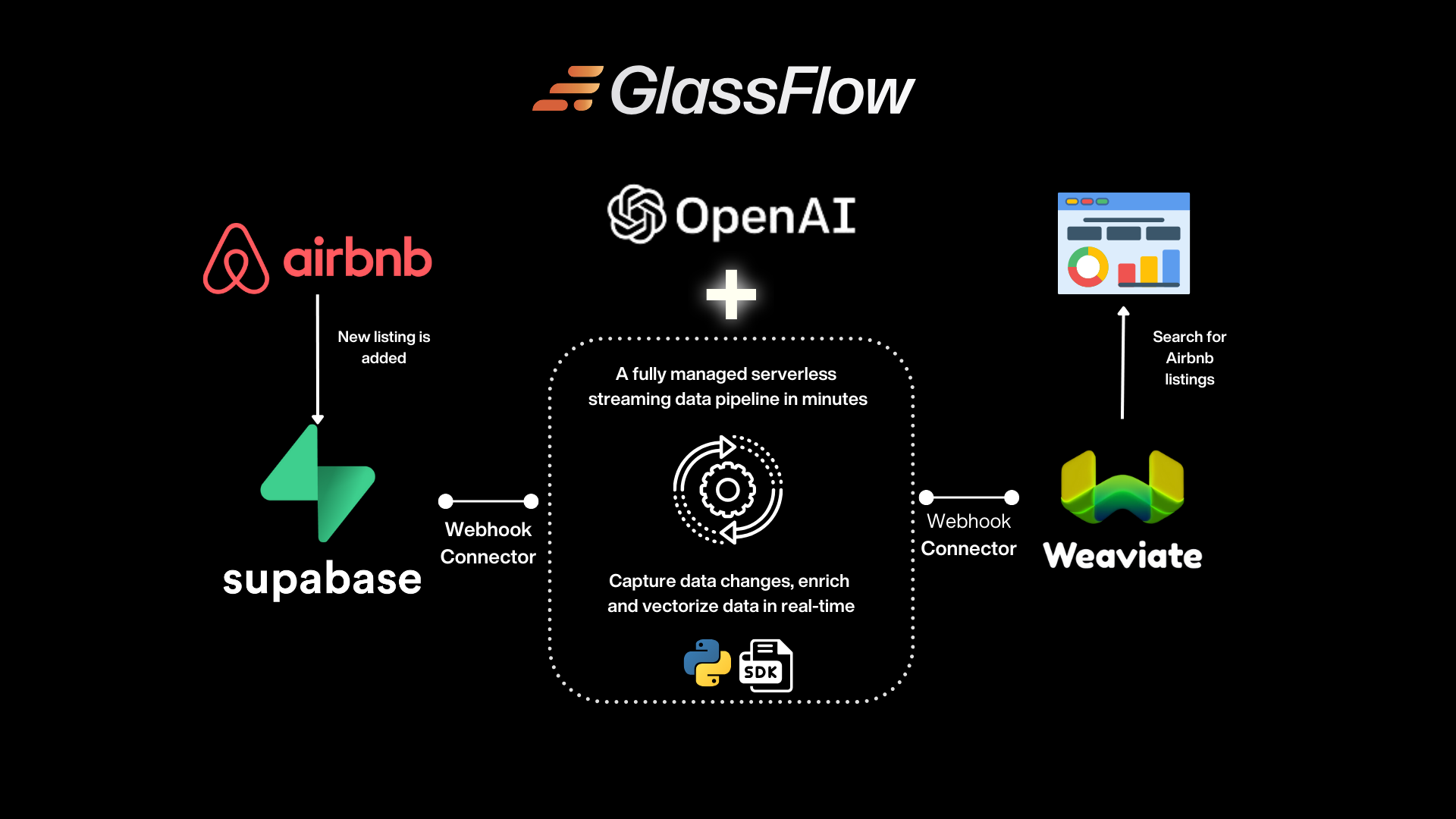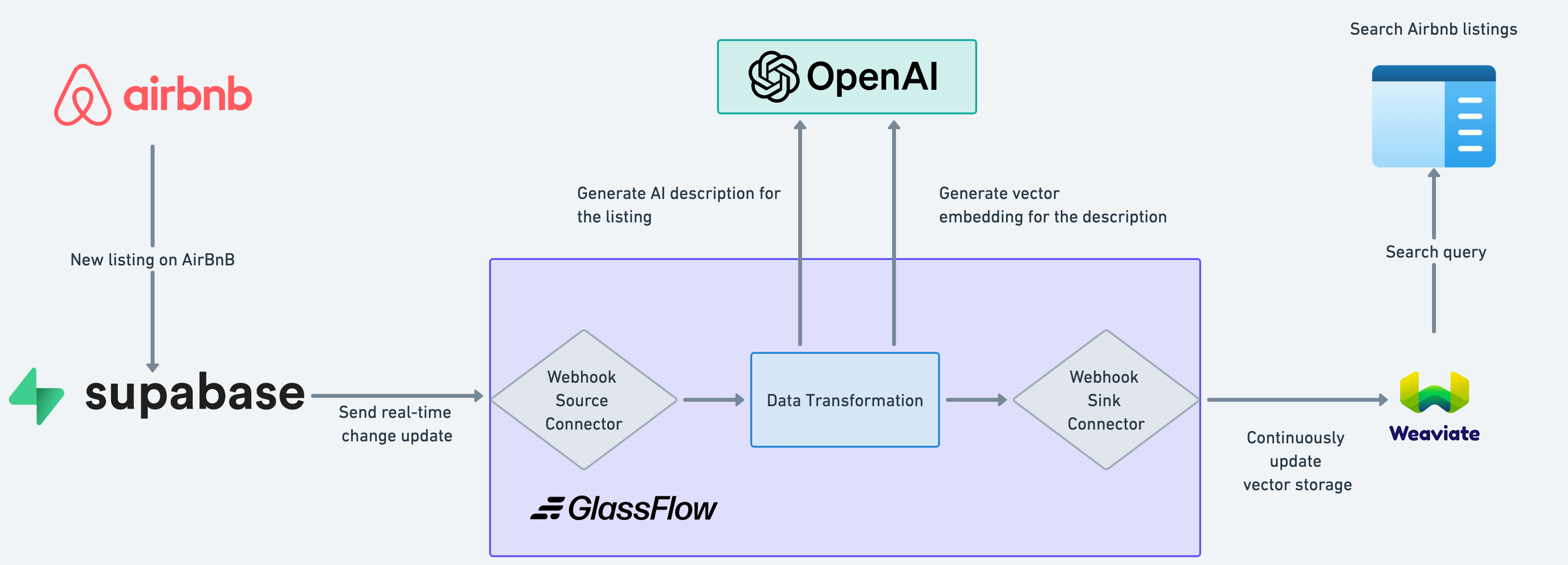Real-time Generative Feedback Loop Automation with GlassFlow, Supabase, and Weaviate
 Bobur Umurzokov
Bobur Umurzokov
Generative Feedback Loops (GFL) are a powerful technique where the results generated from language models like GPT are vectorized and saved back into a vector database. This blog post explores how using GlassFlow, Supabase, and Weaviate can improve how Airbnb listings are managed, ensuring that long descriptions are always optimized for better searching and personalized recommendations. The content can be specifically useful for existing Supabase and Weaviate users looking for solutions for detecting changes on the primary database, streaming these changes, and continuously updating the vector database for AI-powered applications.
What is Generative Feedback Loop Automation and Why is it Important?
Generative Feedback Loops (GFL) takes the concept of Generative AI a step further by introducing a continuous cycle of improvement. In a GFL, the output generated by the AI is not just a final product—it’s part of an ongoing process. The generated content is analyzed, and feedback is collected, which is then fed back into the system to refine the AI’s models and improve future outputs.
What is the difference between Generative AI and Generative Feedback Loop?
GenAI primarily operates in a one-way direction, generating content based on input data. GFL, however, incorporates a feedback loop, where the AI system continuously learns and improves from the outputs it generates.
GenAI is typically used for creating new content or data. GFL is focused on optimizing and improving the AI’s outputs over time through a cycle of feedback and learning. GFL solutions are more complex than standard GenAI models because they require mechanisms for collecting feedback, analyzing it, and adjusting the AI models accordingly.
Real-world Scenario: Dynamic Real Estate Listings
A good example of a GFL in action is personalized recommendations, where an AI might suggest products to a user based on their browsing history, clicks, or purchases. The user’s further interactions with these recommendations provide feedback to AI to refine future suggestions. In the real estate industry, property listings are often updated with new information such as price changes, availability, or added features. A GFL pipeline can automatically update the descriptions of these listings, ensuring they are always current and optimized for search engines. Additionally, by analyzing search patterns, the AI can enhance listings to highlight features that are most likely to attract potential buyers or renters.
Imagine an Airbnb user searching for a cozy apartment in Paris. As new room listings are added, GFL can ensure that each listing's long description is always up-to-date, enhancing search functionality and personalized recommendations. We will build a real-time data processing pipeline for this use case. Let's first understand some concepts.
Why Real-time Data Transformation Matters
Real-time data transformation is the backbone of effective GFL automation. It ensures that data is processed and updated instantly, allowing for immediate improvements and adjustments. In the context of Airbnb listings, this means that as soon as a new room is listed or an existing one is updated, the description can be enhanced by AI and vectorized for better search and recommendation functionalities. Real-time transformation allows businesses to react quickly to new information, providing users with the most relevant and updated content.
Why GlassFlow Can Be Useful
GlassFlow is a powerful tool that simplifies real-time data transformation in Python. It enables you to build and manage data pipelines efficiently in a serverless environment, without the need for complex infrastructure. With GlassFlow, you can integrate various data sources such as PostgreSQL, MongoDB, Google PubSub, or Amazon SQS, apply AI transformations, and store the results in vector databases like Weaviate.
For Airbnb, using GlassFlow means that every new listing or update can be processed in real time, with AI-generated descriptions being continuously optimized and stored. This seamless integration ensures that users always get the most relevant and engaging content, improving their overall experience on the platform.

Pipeline Components for Real-time GFL Automation
The pipeline we'll be building includes the following components:
Data Source: Supabase
Supabase serves as the primary database for storing Airbnb listings. When a new listing is added or an existing one is updated, the data is instantly captured and sent to the GlassFlow pipeline using the Webhook data source connector.
Transformation: AI and Vectorization
GlassFlow leverages OpenAI GPT models such as GPT4o to generate and enhance listing descriptions. These descriptions are then vectorized using the OpenAI vector embeddings endpoint, creating rich, searchable data that can be stored and queried efficiently.
Sink: Weaviate
Weaviate, a powerful vector database, stores the vectorized descriptions. This setup enables advanced search functionalities and personalized recommendations by quickly retrieving the most relevant listings based on user queries.
Expanding the Use Case
The real-time Generative Feedback Loop pipeline isn't limited to Airbnb listings. It can be applied to various other scenarios, including:
Real-Time Job Listings Optimization
Job boards and recruitment platforms can leverage GFL to continuously refine job postings based on trends in candidate searches and applications. For instance, if the AI detects a surge in searches for "remote work" or "flexible hours," it can update relevant job listings to emphasize these aspects, thereby increasing their visibility and attractiveness to job seekers.
Customized Travel Itineraries
Travel agencies and platforms can use GFL to create and refine personalized travel itineraries for their users. By analyzing user preferences and feedback, the AI can suggest alternative destinations, activities, or accommodations that better match the user's interests. For example, if a user frequently searches for "adventure travel" or "cultural experiences," the AI can tailor itineraries to include activities that align with these preferences, thereby enhancing the user experience.
TV Shows: Creating Personalized Viewing Experiences
With GFL, streaming platforms like Netflix can dynamically adjust scenes, dialogues, or even endings of movies and TV shows based on the user’s viewing history, preferences, and emotional responses.
You can also read more use cases mentioned by Connor Shorten with GFL on the Weaviate website.
Summary
Implementing real-time Generative Feedback Loop automation using GlassFlow, Supabase, and Weaviate provides a scalable and efficient solution for platforms like Airbnb. By continuously optimizing and personalizing content, businesses can offer a superior user experience, enhance searchability, and increase engagement. Whether you're managing a few listings or thousands, real-time data transformation with GlassFlow is key to staying competitive in today's fast-paced digital landscape.
By leveraging these advanced tools and techniques, you can ensure that your platform remains at the forefront of innovation, providing users with the best possible experience while optimizing operational efficiency.
Those interested in diving deeper and setting up their own real-time GFL pipelines should head over to the GlassFlow Docs to get started.
Subscribe to my newsletter
Read articles from Bobur Umurzokov directly inside your inbox. Subscribe to the newsletter, and don't miss out.
Written by

Bobur Umurzokov
Bobur Umurzokov
𝐖𝐡𝐨 𝐈 𝐚𝐦 Bobur is a developer advocate and speaker specializing in software and data engineering. With over 10- years of experience in IT, he blogs about open-source technologies and the community around them. 𝐖𝐡𝐚𝐭 𝐈 𝐝𝐨 I work with companies at different scales to build awareness, drive adoption, and engage with the community for your developer-targeted products. I also create inspiring content, design, and code use cases, projects, and demo apps to boost learning your product.